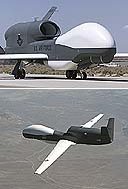Receiving the US Federal Aviation Administration's first certificate of authorisation (COA) has made it easier to operate the Northrop Grumman RQ-4 Global Hawk high-altitude, long-endurance unmanned air vehicle in civilian airspace, in the USA and elsewhere, and is a "baby step" towards the normalisation of UAV operations, says Ed Walby, Global Hawk business development manager.
Before the authorisation was granted last year, an application to access civil airspace had to be filed with the FAA 30 days before each flight. The COA shortens the filing time to five days, permits the UAV to climb and descend through controlled airspace and allows the vehicle to be flown across the USA without having to coordinate with each air traffic control centre along the route. "They treat it as a normal flight," Walby says.
Progress with the Global Hawk is chipping away at scepticism over UAV operations in civil airspace, Walby believes. "It is making the FAA feel more comfortable that the system can be flown and operated safely." There is concern that British newspaper stories alleging the Global Hawk strayed into UK airspace during its recent German demonstration could set things back. There is "zero truth" in the reports, he says, "but they can put doubts in the minds of the public and government legislators."
While the COA was a big step towards normalising UAV operations, it was only a first step, Walby says. The US Air Force plans to develop the Global Hawk's military capabilities in a series of spirals that will also increase the UAV's suitability for civil applications. The RQ-4B production air vehicle has increased redundancy, and an autonomous capability to avoid collisions other airspace users is planned for a later spiral.
Whereas the RQ-4A demonstrator has dual control surfaces in each axis, but only one actuator on each surface, the production vehicle has dual-redundant servos. "In effect we have quad redundancy," Walby says. In the RQ-4B, an uprated 25kVA generator and its 10kVA backup provide two independent power sources for the electric flight-control actuators.
The production Global Hawk also has a fixed forward-looking electro-optical/infrared camera as a first step towards a detect, see and avoid capability. "We are not quite there yet," Walby says. "The system is quite good - it can see 50 miles (80km) ahead - but the FAA's concern is that the current camera does not scan."
The goal is a safety level equivalent to or better than a military aircraft, Walby says. Northrop Grumman calculates the current level of safety is on a par with that of other military aircraft, such as the Lockheed Martin F-16 and U-2, when they were at the same level of maturity. And the operation tempo, with one or two flights a day, is several times higher than originally envisaged at this stage in development.
Certain aspects of unmanned operations may actually improve safety over manned aircraft. For example, "the pilot on the ground may have better situational awareness than a pilot in the air," he says. "The Global Hawk is autonomous but we still need the pilot for situational awareness, to understand air traffic control and for basic air sense," Walby says. At the UAV's present stage of maturity and acceptance, a rated pilot is required but that might change. "The task is more like an air traffic controller than a pilot," he says.
Northrop Grumman and the US Air Force plan demonstrations with each development spiral that will "push the envelope" for UAVs. In addition, as production air vehicles are delivered, the surviving Global Hawk technology demonstrators become surplus to USAF requirements and the manufacturer may use these to conduct demonstrations for other government agencies and potential operators.
"We will upgrade the aircraft as much as we can and then go and fly under other agencies' supervision," says Walby. Discussions are under way on an experiment in Montana, using the UAV to detect and assist in fighting forest fires. The Global Hawk will likely be operated by the Air National Guard or Department of Forestry, he says.
The COA will make it easier to fly such civilian missions, but Northrop Grumman's ultimate goal is for the Global Hawk to "operate normally in all classes of airspace - to launch from Beale [AFB] and land at Chicago [O'Hare] along with other air traffic," says Walby. "This is needed for total flexibility of the system. We cannot afford to be barred from certain airspace."

Source: Flight International























